
The Internet's Premier Classical Music Source
Related Links
- Marais Reviews
- Latest Reviews
- More Reviews
-
By Composer
-
Collections
DVD & Blu-ray
Books
Concert Reviews
Articles/Interviews
Software
Audio
Search Amazon
Recommended Links
Site News
 CD Review
CD Review
Marin Marais

Pièces De Viole, Book V
- Suite #1 in A Minor
- Suite #2 in A Major
- Suite #3 in F Major
- Suite #4 in D Major
- Suite #5 in G minor
- Suite #6 in G Major
- Suite #7 in E Major
Rainer Zipperling, viola da gamba
Ghislaine Wauters, viola da gamba
Pieter-Jan Belder, harpsichord
Wout Oosterkamp, recitant (suite #7)
Brilliant Classics BRI94646 4CDs
Composer Marin Marais was born in 1656 in Paris; he was also a viol player. Marais wrote five collections of viol music; the last one was published in 1725, three years before his death, and at the end of his tenure as ordinaire de la chambre du roy pour la viole. Two things are likely to strike you most forcefully on settling into the four CDs that make up this welcome set, Book V of the Pièces De Viole.
The first quality is the works' breadth and variety. Not only of tempi, pace, length and mood/atmosphere (they're all pieces for one or two violas da gamba with harpsichord accompaniment). But they also delight in real heterogeneity of texture, range, sound world and palette. Listen to the contrast, for instance, between the helter-skelter humor of the A minor's Petit Caprice and the gentler, more reflective Rondeau [CD.1 tr.s 8,9]. Then the highly graphic, faltering and even puzzlingly expressive "La Georgienne dite la Maupertuy" [CD.3 tr.11]; it seems to burst on our ears without precedent. These are typical. It's as though Marais sets out to paint a full canvas with each Suite. He is not content to sketch or outline. Nor does he attempt to make huge daubs of primary colors. Still less to represent figuratively any merely familiar scene which only needs hinting at, sketching.
Rather, Marais has a clear conception of each painting's size, medium (wood, canvas, plaster etc), the tools and colors which he needs to employ and the precise mix of effects… pastel, shininess, transparency, contrast, focus, impression and so on. Then with three instruments only, he builds – usually quickly; always deftly – a composite that conveys extremely well both the totality and the detail of his idea. So for the three musicians performing on these CDs to sustain such inventiveness over four hours is a notable achievement. You're eager to hear what comes next, to be captivated by the next turn of originality and change of hue and detail.
The three players here are indeed fully in tune with the ways that Marais not so much "keeps our interest" as insists, albeit gently and with great (musical) maturity, that we delve in and out of the various colors, shadows, lights and spectra of his sound with him. That's not to say that their playing is in any way untidy or whimsical, still less rough. Rather, it's idiomatic and shot through with the energy that Marais commands at every turn. At the same time, their playing has all the subtleties and purpose needed to convey the richness of the composer's highly original thought.
Secondly, Zipperling, Wauters and Belder are accomplished in the extreme. Their open, polished styles not only work very well together. But they never feel the need to embroider the music as too simple or too similar, one movement to the next. They just let each innovation roll off the page. The contrast, say, between the same A minor's La Mariée and Gavotte [CD.1 tr.s 4,5] is a case in point. The players make the most of a restricted array of instruments to convey a great deal. The technical prowess of gambist, editor, ensemble and soloist as well as recording engineer, Rainer Zipperling, and internationally-renowned performer and recording gambist Ghislaine Wauters and harpsichordist Pieter-Jan Belder mean that they are able to match great confidence with extreme (yet unselfconscious) expressivity.
The instruments used in this recording are all modern: details are given only of the violas from 1992 and 2007 by François Bodart after Barbey and Bertrand respectively. They suit the flavor and range of musical excitement, depth, understanding, originality and reflection which Marais explores in this final summation of his invention. The players have obviously asked themselves the question, Should we be listening to a "reproduction" of how contemporary performers must have approached the music nearly 300 years ago; or are we happy with a modern "reconstruction" with the benefits of hindsight? Their answer is wholly satisfactory: authenticity is at the core of their style and method. Fluidity and delight to the ear, mind and heart are equally central. The way in which the conventional dance movements are blended with those obviously evoking particular people, places and events, as in the amazing sixth Suite [CD.3 tr.s 12-28], for instance, is very compelling.
The acoustic of the recording, the chapel of the Capuchin monastery at Velp (Grave) in the Netherlands, is warm and enhances the playing without overstating the potentially spectacular frieze of this marvelous music. At times the viole da gamba are recorded noticeably more forward than the keyboard. This is not a significant detriment, though. The slim booklet that comes with the CDs is a bit of a disappointment: as well as a track listing, it compacts commentary on the works into just three and a half pages with less for brief biographies of the players. This is important music from an important (and unjustly neglected) composer; more context and detail would have been welcome. Nevertheless, this set from Brilliant is one of but three in the catalog. It's a winner. It's the one to get and should be snapped up by all lovers of Marin Marais in particular and this enthralling Baroque chamber music in general. Definitely recommended.
Copyright © 2014, Mark Sealey




















